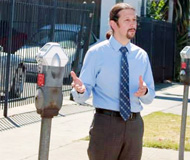Article from: www.thenewspaper.com/news/45/4584.asp
12/10/2014
California Orders Longer Yellow Time At Intersections
Largest state in the country orders an extra half-second of yellow time at red light camera intersections by August.
 Complaints about the short yellow times at intersections are being heard. Last month, California officials approved the recommendations of a state signal timing committee extending the warning times for intersections statewide. These changes have now received the official go-ahead from the Federal Highway Administration.
Complaints about the short yellow times at intersections are being heard. Last month, California officials approved the recommendations of a state signal timing committee extending the warning times for intersections statewide. These changes have now received the official go-ahead from the Federal Highway Administration.
The biggest change is the implementation of the National Cooperative Highway Research Program recommendation that the amount of time given for drivers to stop should be based upon the how fast traffic is actually flowing, not just the number posted on the speed limit sign. Researchers recognized the tendency of local officials to post speed limits below the actual speed of traffic as a method of "traffic calming." After conducting speed surveys, the organization determined that an extra 7 MPH should be added to the calculation of yellow times when the speed limit is not based on actual traffic speeds (view report).
This method now has the force of law in California, and it will have the effect of adding 0.5 second of yellow at most intersections. Localities have also lost the permission given in previous versions of the state traffic manual to time right and left-hand turns as short as 3.0 seconds. Having extra-short yellow only on the turn lanes has created a major source of red light camera revenue, but the new requirement puts the burden on engineers to justify any form of short yellow timing, especially at larger intersections.
"The yellow interval could be challenged if engineers have not set the yellow interval with consideration to the approach speeds of vehicles in dedicated turning lanes especially where they exceed 150 feet," explained Jay Beeber, Executive Director of Safer Streets LA. "While not mandatory, engineers will have to justify, based on their engineering judgment, why a longer yellow interval is not appropriate."
Beeber argued for the changes before a state engineering panel, the California Traffic Control Devices Committee. Beeber is now running for a city council seat in Los Angeles in the March 3 election.
For intersections with a red light camera, the yellow time must be in compliance with the new rules by August 1. For all other intersections, cities, counties and state agencies will have until August 2017 to comply.
California law specifically recognizes that these are "minimum" yellow times, and that jurisdictions should provide longer warning durations when appropriate. An extra half-second of yellow time can make the difference between a money-losing and a money-making red light camera program. Documents uncovered from the 2001 courtroom trial of San Diego's red light camera program, the largest case of its type, found that the private camera vendor specifically placed red light cameras only at intersections with overly short yellow timing (view documents).
The days of the San Diego program are over, and so much attention has been given to signal timing that interest in red light cameras has faded. Nearly sixty California cities have dropped their photo ticketing programs, including Belmont, Bell Gardens, Berkeley, Burlingame, Compton, Corona, Costa Mesa, Cupertino, El Cajon, El Monte, Escondido, Emeryville, Fairfield, Fresno, Fullerton, Gardena, Glendale, Grand Terrace, Hayward, Highland, Indian Wells, Irvine, Laguna Woods, Lancaster, Loma Linda, Los Angeles, Long Beach, Maywood, Montclair, Moreno Valley, Oakland, Paramount, Pasadena, Poway, Rancho Cucamonga, Redlands, Redwood City, Rocklin, Roseville, Rowland Heights, San Bernardino, San Carlos, San Diego, San Jose (photo radar), San Juan Capistrano, Santa Fe Springs, Santa Maria, Santa Rosa, South Gate, Union City, Upland, Walnut, Whittier, Yuba City and Yucaipa. The city councils of Laguna Niguel and Orange passed ordinances banning cameras in 2011. Residents of Anaheim, Murrieta and Newport Beach voted to ban red light cameras at the ballot box.
 Complaints about the short yellow times at intersections are being heard. Last month, California officials approved the recommendations of a state signal timing committee extending the warning times for intersections statewide. These changes have now received the official go-ahead from the Federal Highway Administration.
Complaints about the short yellow times at intersections are being heard. Last month, California officials approved the recommendations of a state signal timing committee extending the warning times for intersections statewide. These changes have now received the official go-ahead from the Federal Highway Administration.